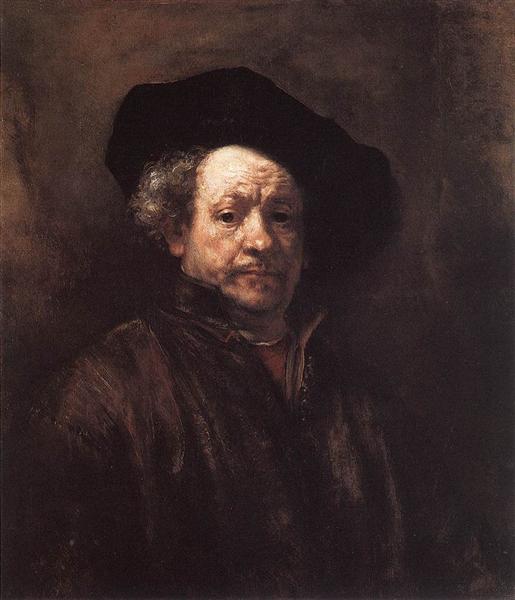Description
The Self-Portrait from 1660 is a masterpiece by the celebrated Dutch painter Rembrandt van Rijn, representing not only a technical exercise, but also a deep psychological exploration by the artist. In this oil on canvas, Rembrandt presents himself with a gaze that seems to cross time, inviting the viewer to enter his inner world. This work is set in a period in which the artist was deeply involved in the search for his own identity, both as a man and as an artist, reflecting not only his technical mastery but also his ability to capture the complexity of the human condition.
The self-portrait shows Rembrandt in the foreground, with a dark background that contrasts sharply with the luminosity of his face. This use of chiaroscuro is a signature technique of the artist, allowing him to model forms and express emotions through the play of light and shadow. The painter's face, marked by time and experience, becomes the focal point of the composition. The serene, slightly melancholic expression suggests deep introspection, while the robustness of his features conveys a sense of wisdom and authority. The details of the face - the wrinkles, the texture of the skin and the deep gaze - reveal an honest vulnerability as well as an unspoken pride in his achievements.
The painting's colour palette, dominated by earthy and ochre tones, lends a sense of warmth and humanity to the work. Rembrandt appears to use a loose brushstroke technique in areas such as his hair and clothing, lending a sense of immediacy and authenticity. This is contrasted with the rigidity of the typical clothing of the period, which, although beautifully executed, do not detract from the expression on the face. The choice to dress in a wide-brimmed hat and a high-collared garment emphasises his artistic identity, suggesting a connection between his life as a bourgeois and his life as a creator.
A particularly interesting aspect of the Self-Portrait of 1660 is the way in which Rembrandt places himself in a temporal and spatial context that allows us to reflect on his own trajectory as an artist. In this work, we can observe the maturity of his style, which had evolved from the influences of Baroque painting and the Flemish tradition towards a more personal and emotional quest. Through his self-portraits, Rembrandt not only documents his own appearance over the years, but also makes a comment on the passage of time and the ephemeral nature of life.
This self-portrait is part of a long tradition of self-portraits in art history, but it is unique in its ability to explore not only the artist's external identity, but also his internal world. Rembrandt's honesty in depicting himself, without embellishment or artifice, establishes an intimate connection with the viewer, who witnesses the shared vulnerability of humanity.
This painting, like Rembrandt’s other self-portraits, aligns with his realist approach, which distances itself from the idealized conventions of portrait painting of his time. Together with his extensive output of self-portraits, this work becomes a visceral testament to Rembrandt’s genius and his exceptional ability to intertwine masterful technique with a profound exploration of the human soul. In this self-portrait, the fusion of light and shadow, color and form, invites us to reflect on our own condition and the never-ending search for identity.
KUADROS ©, a famous painting on your wall.
Hand-made oil painting reproductions, with the quality of professional artists and the distinctive seal of KUADROS ©.
Painting reproduction service with satisfaction guarantee. If you are not completely satisfied with the replica of your painting, we will refund 100% of your money.

